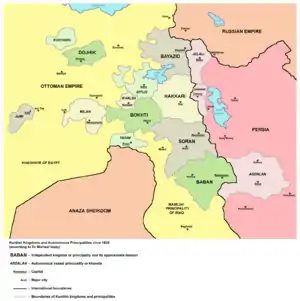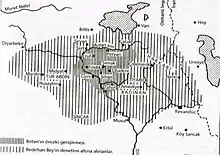Bohtan
Bohtan (also Buhtan, Bokhti) was a medieval Kurdish principality in the Ottoman Empire centered on the town of Jazirah ibn 'Omar (modern Cizre also known as Cizîra Botan (Jazira Botan)) in southeastern Anatolia. Bohtanis were an ancient and prominent branch of the Kurds that claimed descent from the Islamic General and Sahaba Khalid ibn al-Walid.[1] Some minor branches followed Yazidism but Sunni Islam predominated in the 14th century.[2]

 |
History
In the early 8th century Bukhtis and Bajnawi Kurds ruled the area surrounding Sinjar and Jazira mountains known under name Zozan by Arab geographers. Yaqoot Hamawi describes their residing area to be from Ikhlat to Salmas which included many strongholds belonging to Bokhtis; he also mentioned town of Jardhakil as their capital. The principality ruled over an area extending from Diyarbakir to Van and from Rawanduz to Sinjar at its peak.[1] The first governors of Bohtan, were from the Azizoğlu family, who were related to the Governors of the Principality of Bitlis.[3] Following their role in the Ottoman defeat of the Safavids in the Battle of Caldiran in 1514,[3] Bohtan was granted the status of a Hükümet, and it became a hereditary Kurdish principality within the Ottoman Empire.[4]
An important governor of the Bohtan was Bedir Khan Bey, who succeeded Mir Sevdin.[5] Bedir Khan Bey was Mîr of the principality in 1821–1847.[1] Bedir Khan brought security into Bohtan.[6] According to European diplomats in the region, he even tested if the regional chief was observant enough.[6] He would try to raid a tribe by night, and if he succeeded he would punish the tribal chief in who's territory the robbery was successful.[6] He then returned what he had robbed the night before.[6] The security standard in Bohtan was such, that it encouraged the population of neighboring provinces to move into the territory under Bedir Khans control.[7] This led to the opposition by the Ottoman Vali of Mosul, who demanded an end to the emigration of the habitants from the Mosul province to Bohtan.[7] Following, Bedir Khan expelled 2000 immigrants who settled into Bohtan during the Governorship of Mehmet Pasha in Mosul,[7] but they returned after four years.[7] The renewed emigration lead the Vali of Mosul Mehmet Şerif Pasha to file a report against Bedir Khan, who in 1847 hat to agree to bring an end to the immigration of foreigners in Bohtan.[7]

Bedir Khan Bey resigned after an unsuccessful uprising against the Ottoman Empire and following, Bohtan lost its independence[1]
Sub-groups
The main branches of Bukhtis were Brasbi, Dasni and Sindi. According to Sharafkhan Bidlisi in his time few Bukhtis followed Yazidi faith, furthermore he states that previously Bukhtis were among the Kurdish groups who had a large Yazidi branch.[8]
References
- Jongerden, Joost (2012). Social Relations in Ottoman Diyarbekir, 1870-1915. Brill. p. 60. ISBN 9789004225183.
- Nelida Fuccaro, The other Kurds: Yazidis in colonial Iraq, 256 pp., Palgrave Macmillan, 1999. (see p.10)
- Winter, Stefan (2006). "The other Nahdah: The Bedirxans, the Millîs and the tribal roots of Kurdish nationalism in Syria". Oriente Moderno. 25 (86) (3): 461–474. doi:10.1163/22138617-08603003. ISSN 0030-5472. JSTOR 25818086 – via JSTOR.
- Henning, Barbara (2018). Narratives of the History of the Ottoman-Kurdish Bedirhani Family in Imperial and Post-Imperial Contexts: Continuities and Changes. University of Bamberg Press. p. 94. ISBN 978-3863095512.
- Henning, Barbara (2018),p.95
- Gökçe, Hasan (1997). Kieser, Hans-Lukas (ed.), p.80
- Gökçe, Hasan (1997). Kieser, Hans-Lukas (ed.). Kurdistan et l'Europe (in French). Chronos. p. 81. ISBN 978-3-905312-32-4.
- Keo - Religion Archived February 22, 2007, at the Wayback Machine
